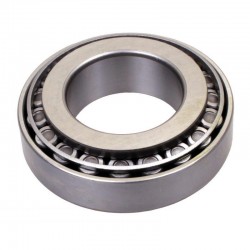Product successfully added to your shopping cart
There are 0 items in your cart. There is 1 item in your cart.
Large delivery of BBC-R bearings. Updating the warehouse.
There are 0 items in your cart. There is 1 item in your cart.
Large delivery of BBC-R bearings. Updating the warehouse.

2.1 Type 2000 - Cylindrical roller bearings - designed to sustain significant radial loads, and only some of them additionally can sustain short-term small axial loads. In rapidity these bearing almost not inferior to deep groove ball bearings. Require accurate axiality of seats. Bearings with cylindrical rollers can vary in design depending on the availability and location of flanges on both the inner and outer rings. They are made with short cylindrical rollers with stamped, solid, plastic cages or without them, single-row, double-row or multi-row. Stamped cages are made of low carbon steel, solid - of brass or aluminum alloys, plastic - of polyamide. To reduce boundary tensions often use rollers with bevel or rollers that have convex profile, forming rolling surface. Cageless bearings have a maximum load capacity by complete filling with rollers.
Cylindrical roller bearings are produced of 0,6 and 5 accuracy class and used in units and mechanisms of general engineering, automotive industry and metallurgy. Bearings type 3182000, 4162000, 3282000 and 4262000 are produced of 2 and 4 accuracy class and used in engineering tools.
2.2. Type 4000 - Needle roller bearings - bearings with a cylindrical rollers of small diameter, which thus have a significant length relative to their diameter. Needle roller bearings have, at minimum radial dimensions, maximum radial load capacity, however, any axial load can be sustained. Needle rollers at the ends are rounded and, as a result of this, appears the linear contact between the needle rollers and raceways, reduces edge voltage, generating breakage of the bearing. For allowable rotation speed cageless needle bearings inferior to conventional roller bearings, they work well in terms of oscillation of a ring, at low amplitude and high frequency of vibrations. They are very sensitive to flex and inconsistencies of seats.
2.3. Type 3000 - Spherical roller bearings - designed to sustain heavy radial loads and simultaneously axial load, acting in both directions and does not exceed 25% size of unused permissible radial load.
They can compensate a significant misalignment, which appears as a result of shaft deflection under load and due to technical errors in the processing of the landing surface or assembly unit. The efficiency of the bearing remains at distortions of inner ring axis due to axis of the outer ring to 2 degrees. Fix the shaft in the axial direction in both sides within existing axial clearances.
Bearings are made of asymmetrical and symmetrical rollers with cylindrical and conical bores of the inner ring, and with fixed and clamping sleeves.
Used in support assemblies and mechanisms with large radial loads and inevitable misalignment of seats. This powerful pumps, fans, reductors and sawmills, rolling machines.
2.4. Type 7000 - Tapered roller bearings - sustain radial and axial loads. The ability to take axial loads depends on the contact angle of the outer ring rolling raceway. With its increasing, axial load capacity increases, while radial reduces. Permissible rotation speed of tapered roller bearings compared to bearings with cylindrical rollers significantly lower, they are about the same as in the spherical bearings. Conical split bearings, allowing to make separate installation and dismounting of inner and outer rings with a set of rollers. Along with the basic design of tapered roller bearings (type 7000) made bearings of the following varieties: